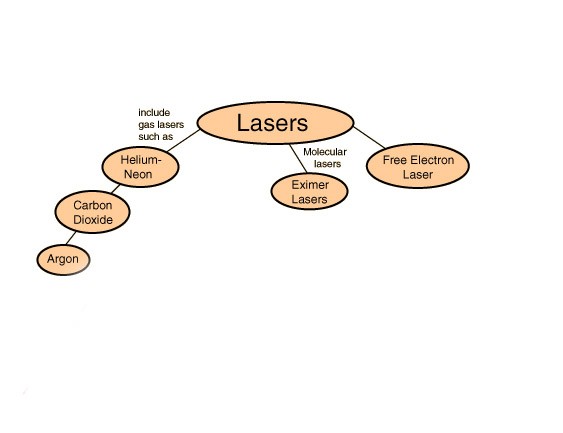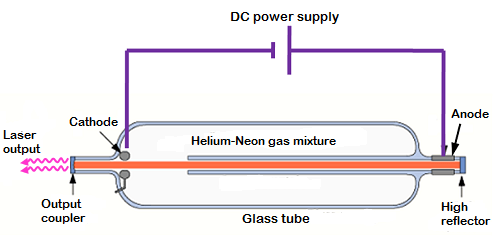Let’s talk about laser types in this post.
According to the type of active medium, we distinguish gas, liquid and solid-state lasers.
In gas lasers, the active medium is a gas or a mixture of gases, and pumping is produced by a gas discharge. Gases are more homogeneous than condensed media, so the light beam in gas is less distorted and dissipated. As a result, the radiation focus of gas lasers reaches the limit due to the light diffraction (the diffraction limit of divergence). The divergence of the light beam of gas lasers in the visible range is ~ 10^-5-10^-4 rad.
In the IR range ~ 10^-4-10^-3 rad.
Types of gas lasers are as follows: atomic (He-Ne), ion (Ar), metal vapor (copper, helium-cadmium laser), and plasma lasers with recombination pumping, molecular (CO2, CO, nitrogen, excimer). The main reason for using certain gas lasers, rather than solid-state lasers, is their special wavelengths, which are difficult to obtain in other types of lasers. Gases at low density are characterized by the Doppler broadening of spectral lines, the magnitude of which is small in comparison with the width of the luminescence line in condensed media. This ensures a high monochromatic emission of radiation in gas lasers.

The most common gas lasers are:
– Helium-neon lasers with emission on quantum transitions between the levels of Ne atoms with a wavelength of 0.6328 μm;
– CO2-lasers on a mixture of gases of carbon dioxide and nitrogen, with emission in the infrared range (a wavelength of 10.6 microns), very high efficiency. (~ 20-30%) and the maximum power of continuous radiation (several dozens of kW).
HeNe laser structure

A special place is occupied by chemical lasers. The source of the chemical energy is chemical reactions between the components of the working medium. There, the energy of the chemical reaction is converted into the energy of coherent electromagnetic radiation. The effect of the chemical laser radiation is opposite to a photochemical effect in which a chemical reaction arises as a direct result of the absorption by an atom or a molecule of a photon. Chemical lasers are mostly used for military purposes, for example, in an anti-missile weapon, which will work even aboard of a large aircraft.
In liquid lasers, active solutions are solutions of organic or inorganic compounds. A distinctive feature of lasers on coloring agents is the ability to work in a wide range of wavelengths from infrared to UV, smooth adjusting of the laser wavelength generation in a range of several dozens of nanometers with monochromaticity reaching 1-1.5 MHz. Lasers on coloring agents operate in continuous, pulsed and pulsed-periodic modes. The energy of the radiation pulses reaches hundreds of joules, the power of continuous generation is dozens of watts, the repetition frequency is hundreds of hertz, and the efficiency is dozens of percents (with laser pumping).
In the pulsed mode, the duration of the generation is determined by the duration of the pumping pulses. In the synchronization mode, a picosecond and subpicosecond range of durations is achieved. The data given refers to different lasers, differ from each other in the design of the resonator, the pumping source, the working substance, etc. But all of them are characterized by the possibility of smooth adjusting of the radiation wavelength, which, in combination with any other set of laser parameters, makes these generators of monochromatic radiation unique. The downside is the difficulty of working with the liquid medium, the specific features of resonator designs and dimensions of the lasers.
In solid-state lasers, the active medium consists of optical single crystals and glass containing an admixture of activator ions (Cr, Nd, Er, transition metal ions). Pumping in TL is external: it is carried out by pulsed and arc discharge lamps, LEDs, etc. Solid-state lasers are most widely known as:
– ruby (Al2O3 + Cr ++) lasers, emitting visible light, a wavelength of 0.6943 μm,
– alumium yttrium garnet lasers with an admixture of neodymium (AIG: Nd3 +), emmitting radiation with a wavelength of 1.058 μm.
Solid-stage laser

Semiconductor lasers belong to the variety of solid-state lasers. Thier active medium is created in the volume of the electron-hole transition when excited by electric current. Various semiconductor compounds (GaAs, InP, PbS, PbSe, AlGaAs, GaInAs, GaP) are used to create semiconductor lasers. arallel planes of the radiating crystal, the size of which does not exceed 1 mm, act as the resonator. Semiconductor lasers have low excitation power, small output power (up to dozens of mW), emit radiation at wavelengths in the range of 0.7-1.6 μm.
Fiber lasers whose active medium and resonator are elements of an optical fiber occupy a special place among solid-state lasers. Their main advantages are high optical quality of radiation, small dimensions and the possibility of integration into fiber lines. The principal advantage of fiber-optic fibers as a laser medium in comparison with volumetric active media lies in low optical losses, a long interaction length and a small diameter of the light-guiding core (usually 4-20 microns), which ensures high pumping efficiency by laser diode radiation.
Fiber laser

The large ratio of the surface area of the optical fiber to its volume radically solves the problem of heat dissipation, allowing creation of fiber lasers with an output power of 1 kW and air cooling. The use of intra-fiber Bragg gratings of the refractive index as distributed reflectors ensures the compactness and high stability of fiber lasers. These circumstances led to the creation of a variety of fiber lasers, including powerful continuous lasers, pico- and femtosecond lasers, single-frequency lasers, and SRS lasers.
The field of application of solid-state lasers is the most extensive: laser technology (welding, cutting, etc.); technology of electronic devices; medicine; laser location; atmospheric composition control systems; optical processing of information; integrated and fiber optics; laser spectroscopy; laser diagnostics of plasma and controlled thermonuclear fusion; laser chemistry and laser isotope separation; nonlinear optics; ultra-fast photography; laser gyroscopes; seismographs and other precise physical instruments.
